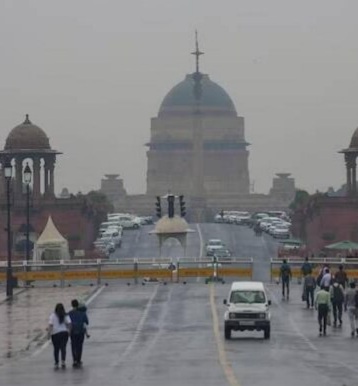When the air in Delhi became very bad, the second phase of restrictions were imposed, this way the air will become clean…
Due to extremely bad air quality in the capital Delhi, restrictions for the second phase of the Graded Response Action Plan (GREP) have been implemented. The air quality index (AQI) here has crossed 300. In such a situation, 11-point restrictions have been imposed under Grape in Delhi-NCR. A recent report by IIT Delhi shows that these measures have helped to some extent in reducing pollution. Let us know what is the impact of these restrictions and guidelines? AQI report of 238 cities of the country has been released by the Central Pollution Control Board (CPCB).
According to this, on October 21-24 (Monday), the capital Delhi was the most polluted in the country with an AQI of 310. At 9 am on Tuesday, it was recorded from 317 to 385 at different places. Anand Vihar recorded 385, Mundka 368, Jahangirpuri 358, Bawana 353, Punjabi Bagh 352, Wazirpur 350, Ashok Vihar 342, Alipore 321, Burari 340 and Dwarka's AQI 324. Second phase restrictions. In such a situation, diesel generators have been completely banned in residential, commercial and industrial units in the second phase of GREP.
Parking charges have been increased to encourage public vehicles in place of private vehicles. Besides, instructions have been given to increase the frequency of CNG-electric buses and metro trains. An appeal has also been made to the common people to minimize the use of private vehicles. There is a complete ban on burning of coal, wood and garbage anywhere. The purpose of these measures is that smoke accounts for the largest share in air pollution.
Data collected by Indian Institute of Tropical Metrology (IITM), Pune, Ministry of Earth Sciences, has also confirmed that vehicle smoke has the highest contribution of 10.96 percent in the air pollution of the capital. . The contribution of stubble smoke is 3.19 percent. There is also a possibility of further increase in stubble smoke. In such a situation, if people follow whatever restrictions have been imposed and smoke emission is reduced, then it can be very effective in dealing with air pollution. Despite Diwali being near, manufacturing, storing and burning of firecrackers will be banned in Delhi till January 1, 2025. But it has been banned. Usually, firecrackers start burning before Diwali.
During festivals, so many firecrackers are burnt simultaneously that the AQI of small towns crosses 400. If the government is successful in banning firecrackers in Delhi, then it is certain that it will help to a great extent in curbing pollution. Arrangements to reduce dust particles will also be made under the 11-point action plan of GREP-2 to stop the dust flying on the roads. Arrangements have been made for machine cleaning. The dust picked up from the roads will not be left on the spot, so that it does not spread again. It will have to be collected and transported to the landfill site. Arrangements have also been made to sprinkle water from time to time. Along with this, to control dust, a special solution mixed with water will be sprayed with sprinklers every other day.
Water mixed with the solution has to be sprayed even on roads with high dust, hot spots and high pressure of vehicles. Due to this, pollution is also controlled by reducing the dust particles in the air. People have got relief from the measures being taken to reduce pollution in Delhi. This has been revealed by a recent study report of IIT, Delhi. This shows that tackling scattered sources of air pollution in Delhi has led to a 15 to 26% decline in PM-2.5 (extremely small pollutant particles) in three clusters of the city. IIT Delhi has conducted a study on scattered sources of air pollution in Delhi. In its study titled Impact of Source Programme, we have evaluated the impact of scattered sources on reducing PM-2.5 at local level.
The scattered sources of these pollution include scattered garbage, illegal dumping of waste from under-construction houses, burning of coal, wood and garbage, broken footpaths and broken roads. This is how IIT Delhi conducted the research. IIT Delhi conducted its study. For this, 35 portable sensors were installed in Jahangirpuri, Rohini and Karol Bagh. These already had a continuous ambient air quality monitoring system in place. Apart from this, IIT-Delhi also collected data from the nearest continuous air monitoring stations. This revealed that PM-2.5 levels have declined in all three clusters. While PM-2.5 levels have decreased by 26.6% in Jahangirpuri, 15.7% in Rohini and 15.3% in Karol Bagh.
Post Views: 190


Comments are closed.